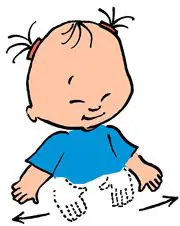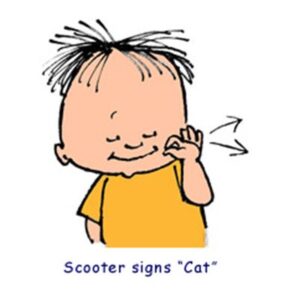Frequently Asked Questions
Starting the Baby Signs® adventure is a very exciting experience for parents and caregivers. You may also feel like you have some questions. Here are some of the most common questions we answer about the Baby Signs® Program.
Since the publication of the first Baby Signs® book, many people have asked how using the Baby Signs® Program relates to American Sign Language, the official language of the deaf community. The simple answer is that the Baby Signs® Program incorporates the most useful, "baby-friendly" signs from American Sign Language. It combines them with signs babies and parents have created and found particularly useful.
When we first began our Baby Signs® Research, we feared that parents of hearing babies would find ASL too overwhelming to learn in the short time their baby would use signs as a bridge to speech. We also knew that young babies, with their limited motor coordination, could not master many of the complex "hand shapes" of ASL. Since hearing babies using sign language is simply a temporary bridge to speech, our goal has always been to do what is easiest for babies and their parents. Our focus has not been to teach hearing babies a second language, but to provide them with the signs they can use most easily to express their needs, thoughts, and feelings until they have words. Research has shown that signs are easiest for babies and for parents when they involve simple gestures and when they resemble the things they stand for (e.g., fingers to lips for "eat," arms out straight like wings for "airplane"). The signs featured in our books and products, whether from American Sign Language or not, have been selected based on what has worked best for babies and their parents.
In revising the Baby Signs® Dictionary, we asked parents to help us make a list of 100 things that their babies need and want to "talk" about. Using our knowledge of babies' motor development and the advice of our colleagues, we carefully evaluated the motor complexity of the ASL sign for each concept. As a result, our Baby Signs® Dictionary now includes many ASL signs that both express important concepts and are easy enough for babies to do. In many cases, the Baby Signs® Dictionary includes multiple sign suggestions, so you can choose which works best for your baby. The Baby Signs® Dictionary can be found in the revised edition of our book, Baby Signs: How to Talk with Your Baby Before Your Baby Can Talk.
We strongly support the importance of American Sign Language for the deaf community, and certainly understand its value for hearing children communicating with deaf relatives or friends. Other parents of hearing babies may opt for signs primarily from American Sign Language should they wish to teach their children this vital and rich language. By clearly indicating in the revised Dictionary which Baby Signs® are also ASL signs, we provide all families with an easy way to get started on the road to successful communication.
Most important, however, is doing what works most easily and joyfully for your family. Using the Baby Signs® Program is about communication, understanding, and intimacy between you and your baby. In the end, whatever signs you use, you are opening the world to your baby and your baby's world to you.
Absolutely not! In fact, in a long-term Baby Signs® study funded by the National Institutes of Health and conducted at the University of California, we found the exact opposite true: Using signs makes it easier for babies to learn to talk.
When we compared children who had been encouraged to use signs with children from the same areas who had not, we found that the Baby Signs® babies consistently scored higher on standardized tests of both receptive language development (how much they understand) and expressive language development (how much they can say).
Communicating requires thinking, planning, and decision-making (e.g., "Hmm, is that a bird or a duck?"). Each one of these activities stimulates the developing brain in important ways that benefit the child the next time. Because signing enables children to communicate at remarkably young ages, Baby Signs® babies enjoy a "jump start" in developing the neural substrate of language.
When babies use signs to call attention to things, adults naturally respond with many appropriate words (e.g., "Oh! You see a kitty! That's right! That is a kitty! That kitty looks just like our kitty, doesn't it!"). And we know that the more language a baby hears, the faster language acquisition proceeds.
We all find it easier to learn about things we are interested in. With signs at their disposal, babies can direct their parents' attention to objects they find fascinating, rather than just listening to labels for things their parents think are important.
Just as learning to crawl is so exciting that it inspires babies to learn to walk, signing whets a baby's appetite for even better ways to communicate. In other words, the motivation to learn to talk increases rather than decreases when you encourage your baby to communicate with signs.
Start whenever you'd like, but certainly by 8 or 9 months. Some families begin as soon as their baby is born to get into the habit, and that's fine. After all, we talk to babies from the day they're born (or even earlier); we don't worry when they don't answer!
The answer varies enormously from baby to baby, depending on a child's interest in communicating (some babies prefer climbing bookshelves to reading books), development of related skills (e.g., memory, imitation, attention), and the frequency with which parents model the signs. The most typical age range for first signs is between 10 and 14 months.
It's important to remember that the younger the child is when you begin modeling - even within this age range -- the longer it will take for those first few signs to appear. After that, it's "off to the races!"
For example, Linda's son, Kai, didn't produce his first sign until he was 12 months old. However, once the proverbial "light bulb" came on, he added new signs quickly-about14 new signs within 3 weeks. Eventually, Kai had a repertoire of more than 40 signs, which he used very productively until he hit his "verbal spurt" at 19 months (from 7 to 74 verbal words in a single month!).
Even babies with 50 to 100-word vocabularies still find some words too hard to say (e.g., hippopotamus, crocodile). As long as that's the case -- no matter the child's age -- we've found that sign equivalents are welcome.
Signing with babies is growing in popularity among directors of childcare programs. The Baby Signs® Program has developed an Early Childhood Educator Curriculum to help large and small child care providers incorporate signing in to their classrooms to service this trend. We are currently working with both Bright Horizons and Mini-Skools, two major childcare corporations, to help them add the Baby Signs® Program to their curricula.
American Academy of Pediatrics’ Heading Home with Your Newborn (2011): “Infant sign language does deliver on its promise of improved communication…. It’s easy to see why so many parents swear by it, why child care centers include it in their infant and toddler classrooms, and why it has become so commonplace as an activity of daily learning” (pp.173-174).
As more and more parents learn the value of exposing their children to second and third languages early in life, the number of babies raised in “bilingual homes” is rapidly increasing. Just what does this mean? In many cases, one parent speaks one language to the child while the other speaks a second. In other cases, both parents may speak the same language to the child, while a trusted caregiver (grandmother or nanny) speaks another. So, what happens if we add signing to the mix? Will it just add to the child’s confusion?






